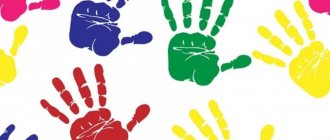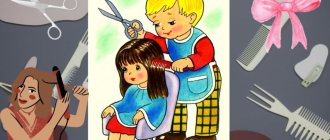Scientists say that creative thinking helps humanity solve many problems and achieve great achievements. You need to learn to think creatively from an early age, and interesting games that will captivate not only children, but also parents will help with this.
The importance of creativity games for children
Stanford University professor Dan Kline says that every person has a large reserve of creativity that will help find a suitable solution in any situation. You can imagine the reserve of creativity in the form of a treasure chest. When a problem arises, an idea is taken from the treasured chest and brought to life. Unfortunately, many people, for some reason, open the chest and take advantage of its contents.
And when it is necessary to make a non-standard decision, a person uses proven methods and does not approach the situation creatively. To overcome the fear of something new and original, you need to develop creative thinking from childhood. And exciting games can help with this.
How the game can help:
- development of hidden abilities;
- the ability to draw conclusions from one’s mistakes;
- lifting your spirits;
- creating a fun, relaxed environment;
- development of imagination and creative potential.
Didactic games in fine arts in the middle group
For older children, offer games to develop color vision and imagination, the ability to understand the mood of a picture, compose figures and patterns in compliance with symmetry and spatial relationships.
Cheerful caterpillar
Make circles in different shades. Tasks for children - to make caterpillars from circles in different variations:
- from dark to light shades;
- from cold to warm.
Colorful arithmetic
The circles used for the previous game can be used for another activity that develops color perception. Additionally, draw arithmetic signs: plus, minus, equal. Make the circles in different ways, and the students must guess what shade they will get.
For example:
- red + yellow = orange;
- green – yellow = blue;
- blue + white = light blue.
Palette
Paint the seasons using 4 separate palettes. Place landscapes (autumn, winter, spring, summer) in front of the students. Showcase the palettes you used. The task is to determine by the combination of colors what palette each landscape was painted with.
Bunny
The game develops imagination. Children learn schematic representations of living beings.
For this lesson you will need ovals of different sizes and elongations cut out of cardboard. Invite the players to create a bunny standing on its hind legs from the available figures. If desired, let the children try to place other animals.
Decorate your mitten
The game teaches how to create patterns taking into account spatial relationships and symmetry. Place a mitten cut out of paper and a set of geometric shapes in front of your child. The task is to create a beautiful and symmetrical pattern.
Playing in visual arts can instill the skill of cooperation and interaction. To do this, divide the kindergarteners into pairs and distribute mittens: one with the right one, the other with the left. Let them try to make the same patterns.
Plasticine vase
Let the child connect 2-3 small pieces of plasticine of different shades and knead them well to obtain streaks reminiscent of marble. From the resulting mass he will fashion a vase.
Magic palette
The game develops the perception of the colors of the surrounding world and an emotional response to the beauty of nature.
Give participants square colored cards. Name a natural object. Children must remember how it is colored and pick up the corresponding cards. For example, with the word “birch”, white, black, green squares should be raised. When you hear the word “chamomile” – yellow, white, green. The participant who picks up the wrong card is eliminated.
Painted horses
The game reinforces the idea of the main types of Russian folk paintings.
Prepare painted horses and images of four pastures called “Gzhel”, “Dymka”, “Gorodets”, “Filimonovo”. The child must say what painting each figurine is decorated with and place it in the corresponding pasture.
Artistic constructor
Distribute pencils and sheets of paper with outlines of simple shapes to the students. Offer to complete the images to create recognizable objects.
Game "Celebrating Mistakes"
The ability to improvise helps a person both in non-standard situations and in everyday life. Since improvisation requires courage, the exercise should be carried out in trusted company, where no one will ridicule or speak negatively. So, we learn to “celebrate mistakes.” You need to perceive mistakes as a gift that helps you draw conclusions. But every time we are afraid of making mistakes, we act too cautiously, and this prevents us from thinking creatively.
The point of the game is as follows. Participants sit in a circle, and each player in turn says: “I made a mistake,” “I was wrong,” “I did everything wrong,” etc. Let adults observe the facial expressions with which children pronounce such phrases. Surely, at the same time, the child shrinks, as if he wants to become invisible in order to avoid punishment for a mistake. People are afraid of criticism, they are afraid of a negative reaction from others. Now invite the players to say the same phrases with joy, as if they want to celebrate a great event.
Diagnostics of gaming activity
Educational activities in kindergarten are carefully analyzed. Moreover, the analysis of the components of the educational process is carried out by the teacher himself, methodologists and colleagues. Self-analysis is necessary to identify and correct shortcomings in the organization and conduct of games, and third-party commentary is needed to draw up an overall assessment of the teacher’s competence in organizing the educational process. If we talk about a general assessment of the play activity of children in a group, then the teacher prepares such a report at the beginning and end of the school year. To do this, he uses an algorithm, which can be seen here https://yadi.sk/i/h9xM3BE53SLSwU
Since the child plays not only in preschool, but also at home, parents are involved in the analysis of the child’s play activity. The analysis scheme in the form of a questionnaire for moms and dads can be found here https://yadi.sk/i/K5T4siNu3SLSwk
To formulate conclusions regarding the level of development of the child’s play activity, the teacher uses the results obtained, describing them in free form based on the data obtained.
Diagnostics of gaming activity, among other things, helps determine how quickly children get involved in the game
Play activity is the leading activity for a child in the preschool period. That is why all elements of the educational process in preschool educational institutions fit into the game form. This makes it possible to realize a wide range of goals and objectives in preparing children 6–7 years old for the next stage of education—school. At the same time, the responsibility for choosing the content and form of the game, as well as preparing, conducting the fun and drawing up diagnostic cards for the level of development of gaming activity falls on the shoulders of the teacher.
Game "False Memories"
Often creative ideas from partners help achieve incredible success. Work is based on the principle of joint cooperation, and it is very important to hear your partner and accept even a seemingly crazy idea.
The game "False Memories" is the following. Two participants pretend that they have known each other all their lives, they have common affairs and interests. The first participant says: “Remember, you and I...”. Then you can fantasize, for example:
- flew into space;
- went on a trip around the world;
- got into a cartoon;
- explored the depths of the sea;
- found a time machine, etc.
You don’t have to come up with implausible fantasies; you can also make up some realistic story.
1st participant:
“Do you remember when we climbed into our neighbor’s garden and wanted to steal apples? And then they ran away because a neighbor noticed us?”
The second player must refute what the first player said.
2nd participant:
“No, it wasn't like that at all. A dog chased us, but the neighbor managed to lock it in the enclosure, and then invited us to visit.”
The story continues, and the participants offer their options for the development of non-existent events. Thus, players learn to refute their opponent's words, but do it creatively, offering their own version. The game turns out to be fun, interesting and not boring.
Game "I agree"
A variation of the previous game, only here the participant, on the contrary, agrees with everything that the second player comes up with. In this exercise, it is important to show your opponent from the positive side, to highlight his best qualities. We must remember that improvisation is not a field for ridicule and cruel jokes.
1st participant: Do you remember how we went to the ocean?
Participant 2: Yes, the weather was beautiful!
1st participant: And watched the crabs?
2nd participant: You were still fishing!
1st participant: And you brought me delicious lemonade!
The game reveals creative potential and teaches you to instantly use your imagination. A person can think critically, but for creative development it is also important to improvise, think positively, and not evaluate the actions of people around him.
Didactic games in fine arts in the preparatory group
When preparing kindergarteners for school, it is important to teach them to describe pictures and their feelings from what they see, to show imagination in everyday life, and to be attentive and observant.
Guess the picture
For the game, prepare reproductions of paintings familiar to kindergarteners. Describe each image verbally and let the children guess what it is about. For example: “In a bright room, a girl in a pink jacket is sitting at a table, she has a fruit in her hands” - this is “Girl with Peaches” by Valentin Serov. Or: “A mother bear and three cubs are frolicking on fallen trees in the middle of a pine forest” - this is “Morning in a Pine Forest” by Ivan Shishkin.
Guess by profile
Prepare recognizable contour profiles of fairy-tale characters: Baba Yaga, Kashchei, the Little Humpbacked Horse, the Serpent Gorynych and others. Children must guess who is pictured.
What does the painting smell like?
Show your students reproductions of paintings. Let them imagine what smells they will smell when they suddenly find themselves inside the painting.
How does the picture sound?
The game is similar to the previous one, only here they imagine not by smell, but by hearing. Let the children imagine what sounds they will hear when they are inside the painting.
What do clouds look like?
If the weather and sky conditions permit, take the group for a walk. If not, find beautiful photos of cumulus clouds. Invite students to imagine what they look like. Emphasize that clouds come in different shapes and sizes.
What's missing?
Show the children some reproductions of famous paintings. Cover up any detail in the images. Show the pictures again and ask them to remember which element is hidden.
Portrait of a neighbor
The game teaches you to correctly and correctly describe a person.
Give participants cardboard frames. Let everyone, bringing the frame closer to their neighbor’s face, try to create a verbal portrait of him.
Game “Distract the Inner Monster”
A terrible dragon lives inside every person, that is, fear, which is usually very difficult to cope with. Acclaimed director Keith Johnstone offers this game to harness your inner dragon.
In one minute (it’s better to set a timer on your phone), write a short story on a piece of paper. It is important to invest in the set time, but to make it easier for players, you can offer the first phrase with which the story will begin. Players turn on their imagination and come up with the most incredible stories, while not using their inner critic, but revealing their creative potential.
Game "Associations"
The player needs to look around and select any object that comes into view. For example, a person noticed a flowerpot with a flower. Then you need to write down on paper 6-7 adjectives that fit this subject, for example:
- Beautiful;
- beige;
- unusual;
- bright;
- clay;
- fragile;
- stylish.
After this, you need to write 6-7 more adjectives that are not at all suitable for the chosen subject. For example, a flowerpot cannot be:
- fried;
- wrinkly;
- salty;
- funny;
- sad;
- silk;
- poor.
Fantasy lives in every person, but you need to be able to use your creative potential. The more creativity is developed, the more unusual, interesting ideas can be used in a variety of life situations.
leave a comment
Didactic games in fine arts in the younger group
Let's consider what classes in fine arts can be taught to pupils aged 2-3 years. Making each game presented with your own hands using fine art is as easy as shelling pears.
Choose a color for the item
Prepare 6 sheets of colored paper. Find images of 6 objects that match in color. Cut out the objects according to the shape so that when you apply the image to the paper, each object acquires the desired color:
- tomato – red;
- carrot – orange;
- lemon – yellow;
- apple – green;
- flower – blue;
- eggplant – purple.
Cockerel
Draw a cockerel using 5-7 colors. Prepare a palette - small squares of different colors, including those that are present in the colors of the bird. The children's task is to find squares that match the color of the cockerel.
Assemble the pattern
Create simple patterns from geometric shapes and floral elements. Cut out shapes of similar colors and shapes separately. Let the children assemble the pattern according to the sample.
Choose by color
The game is designed to reinforce the names of the main colors. Children activate self-control when perceiving colors.
Take a box containing at least 10 colored pencils. Show the students each pencil in turn, asking them to name objects of a similar color located in the room or outside the window.
Make up a picture
There are visual and didactic games that develop intelligence, the ability to concentrate, compare, and analyze.
Find pictures that clearly depict vegetables and fruits, cut them into 4-6 parts. Invite the children to reconstruct the image.
Balloons
Cut out circles and ovals - the base of the balloons. Make strips separately - these will be the strings for the balls. Lay out the blanks on the table. Ask your child to match the balls with strings of a similar color.
Match the saucer to the cup
The game not only develops the skill of distinguishing shades of the palette, but also develops concentration and motor skills of the fingers.
Prepare a canvas that imitates store shelves, make dishes of different colors from cardboard. Tell the children that the saucers were brought to the store first, then the cups. Vendors need help arranging dishes correctly. The players' task is to choose the right saucers for the cups.
Unusual picture
The game develops imagination in younger preschoolers.
Place a wide plate on the table in front of each student and sprinkle with semolina. Explain that semolina is not only tasty, it is so fine and crumbly that you can use it to create beautiful pictures by drawing with your finger.
Pick up red items
For the game, prepare various small objects (or cards representing them). Dress the doll in a red dress. Tell the students that a girl Masha came to them and asks them to help her choose items of the same color to go with her red outfit. Children take turns taking cards and saying whether the depicted object can be red. If yes, put the picture in Masha's doll's purse.







